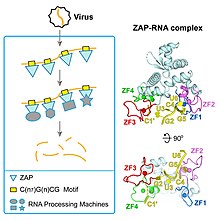Antiviral protein

Antiviral proteins are
Pokeweed antiviral protein and the Zinc-Finger antiviral protein are two major antiviral proteins that have undergone several tests for viruses, including HIV and influenza.[citation needed
]
Pokeweed antiviral protein
Pokeweed antiviral protein (PAP) is a
ribosome inactivating protein
that provides
ZC3HAV1
ZAP (Zinc finger Antiviral Protein) is encoded by the ZC3HAV1 gene[4] whose expression is induced by interferon and helps fight a number of viral infections including influenza.[5]
IFITM3
Interferon-induced transmembrane protein 3 (IFITM3) inhibits the replication of number of enveloped RNA viruses including influenza A, HIV and the Ebola and Dengue viruses.[6] Consequently pharmacological induction of IFITM3 potentially could be used to treat a number of viral infections.[5]
Protein kinase R
double-stranded RNA (occurring as an intermediate in RNA viruses replication) or by other proteins. It is able to phosphorylate the eukaryotic translation initiation factor eIF2α thus inhibiting further cellular mRNA translation.[7]
